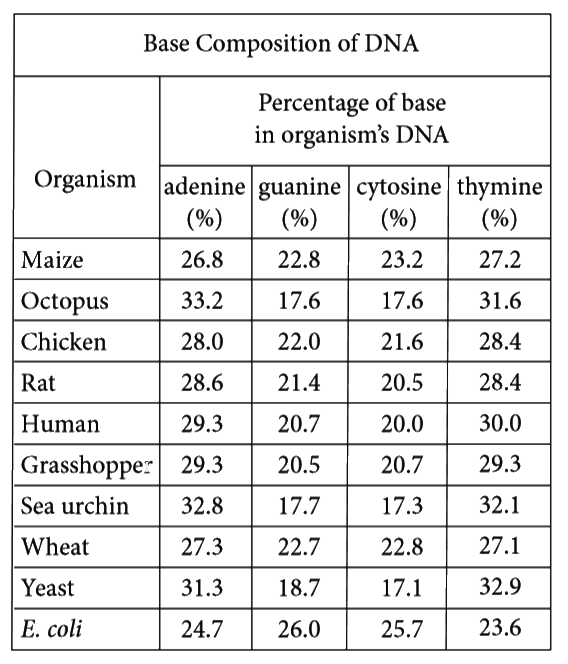The chemical formula of deoxyribonucleic acid
(DNA) is now well established. The molecule is a
very long chain, the backbone of which consists of a
regular alternation of sugar and phosphate groups.
5 To each sugar is attached a nitrogenous base, which
can be of four different types. Two of the possible
bases—adenine and guanine—are purines, and the
other two—thymine and cytosine—are pyrimidines.
So far as is known, the sequence of bases along the
10 chain is irregular. The monomer unit, consisting of
phosphate, sugar and base, is known as a nucleotide.
The first feature of our structure which is of
biological interest is that it consists not of one chain,
but of two. These two chains are both coiled around
15 a common fiber axis. It has often been assumed that
since there was only one chain in the chemical
formula there would only be one in the structural
unit. However, the density, taken with the X-ray
evidence, suggests very strongly that there are two.
20. The other biologically important feature is the
manner in which the two chains are held together.
This is done by hydrogen bonds between the bases.
The bases are joined together in pairs, a single base
from one chain being hydrogen-bonded to a single
25 base from the other. The important point is that only
certain pairs of bases will fit into the structure.
One member of a pair must be a purine and the other
a pyrimidine in order to bridge between the two
chains. If a pair consisted of two purines, for
30 example, there would not be room for it.
We believe that the bases will be present almost
entirely in their most probable forms. If this is true,
the conditions for forming hydrogen bonds are more
restrictive, and the only pairs of bases possible are:
35 adenine with thymine, and guanine with cytosine.
Adenine, for example, can occur on either chain, but
when it does, its partner on the other chain must
always be thymine.
The phosphate-sugar backbone of our model is
40 completely regular, but any sequence of the pairs of
bases can fit into the structure. It follows that in a
long molecule many different permutations are
possible, and it therefore seems likely that the precise
sequence of bases is the code which carries the
45 genetical information. If the actual order of the bases
on one of the pair of chains were given, one could
write down the exact order of the bases on the other
one, because of the specific pairing. Thus one chain
is, as it were, the complement of the other, and it is
50 this feature which suggests how the deoxyribonucleic
acid molecule might duplicate itself.
The table shows, for various organisms, the percentage of
each of the four types of nitrogenous bases in that
organism’s DNA.

Adapted from Manju Bansal, “DNA Structure: Revisiting the
Watson-Crick Double Helix.” ©2003 by Current Science Association,
Bangalore
23. A student claims that nitrogenous bases pair randomly with one another. Which of the following statements in the passage contradicts the student’s claim?
Lines 5-6 (“To each . . . types”)
Lines 9-10 (“So far . . . irregular”)
Lines 23-25 (“The bases . . . other”)
Lines 27-29 (“One member . . . chains”)
The correct Answer is:D
The authors explain that hydrogen bonds join together pairs of nitrogenous bases, and that these bases have a specific structure that leads to the pairing: “One member of a pair must be a purine and the other a pyrimidine in order to bridge between the two chains” (lines 27-29). Given the specific chemical properties of a nitrogenous base, it would be inaccurate to call the process random.
Choice A is incorrect because lines 5-6 describe how nitrogenous bases attach to sugar but not how those bases pair with one another. Choice B is incorrect because lines 9-10 do not contradict the student’s claim. Choice C is incorrect because lines 23-25 describe how the two molecules’ chains are linked, not what the specific pairing between nitrogenous bases is.
Similar Questions
25% और 40% सान्द्रण वाले अम्लों को मिलाकर 30% सान्द्रण का 60 लोटर अम्ल बनाया जाता है। प्रत्येक प्रकार के अम्ल को आवश्यकता होगी?
View Solution5 पेन और 6 पेसिलो का कुल मूल्य 9 तथा 3 पेन और 2 पेसिलो का कुल मूल्य 5 है । एक पेन का मूल्य तथा एक पेंसिल का मूल्य ज्ञात कीजिए ।
View Solutionएक यौगिक A तथा B तत्वों से मिलकर बना है । जब A परमाणु कोने पर तथा B परमाणु केंद्र पर हो, तो यह यौगिक घनाकार जालक में क्रिस्टल बनाता है । यौगिक का साधारण सूत्र होगा :
View SolutionA तथा B धातु युक्त द्विअंगी मिश्रधातु के इकाई सेल की ccp संरचना है जिसमे A परमाणु कोनो पर तथा B परमाणु घन के प्रत्येक फलक के केंद्र पर स्थित होते है । यदि इस मिश्रधातु के क्रिस्टलीकृत के दौरान, इकाई सेल में दो A परमाणु लुप्त हो जाते हैं, तब प्रति इकाई सेल का पूर्ण संघटन होगा :
View Solutionसमान चालकता सेल में लिए गए दो विलयनों A तथा B के प्रतिरोध क्रमशः 50 ओम तथा 100 ओम है । यदि A व B के सामान आयतन मिला दिए जाये तो सामान चालकता सेल में मिश्रण का प्रतिरोध क्या होगा ?
(मोल A व B को मिलाने पर वियोजन की मात्रा में कोई परिवर्तन नहीं होता है)
View Solutionयदि A और B दो स्वतंत्र घटनाएँ हो तो
View Solution15∘C पर 5% गन्ने की शक्कर का परासरण दाब है-
View Solutionनिम्नलिखित में से किसका अबसे अधिक द्विध्रुव-आघूर्ण है?
View Solution
